John Watson Book Reviews (99)
History and General Works Part 4. John Watson Book Review #99
IM John Watson - Saturday 22nd January 2011

The Mammoth Book of Chess, 3rd Edition by Graham Burgess. | http://www.theweekinchess.com
John Watson covers more recent books of a variety of styles. (see also Review 97 and Review 98). This time he looks at: The Mammoth Book of Chess, 3rd Edition by Graham Burgess, Chess Gems: 1000 Combinations You Should Know by Igor Sukhin, Chess Child: The Story of Ray Robson by Gary Robson, Champions of the New Millennium by Lubomir Ftacnik, Danny Kopec & Walter Browne, Masters of Technique by Howard Goldowsky, Vienna 1922 by Larry Evans, New York 1927 by Alexander Alekhine and London 1922 by Geza Maroczy.
This column is simply a continuation of the last two, with a more-or-less arbitrary division point for the books examined. Anything I said in the introductions there presumably applies here as well!
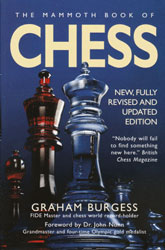
The Mammoth Book of Chess, 3rd Edition; Graham Burgess; 570 pages; Constable and Robinson

Chess Gems: 1000 Combinations You Should Know; Igor Sukhin; 335 pages; Mongoose Press
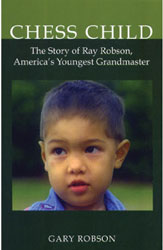
Chess Child: The Story of Ray Robson, America's Youngest Grandmaster; Gary Robson; 281 pages; Nipa Hut Press 2010
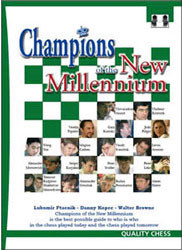
Champions of the New Millennium; Lubomir Ftacnik, Danny Kopec & Walter Browne; 453 pages; Quality Chess 2009
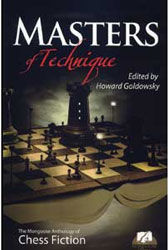
Masters of Technique - The Mongoose Anthology of Chess Fiction; Howard Goldowsky, Editor; 286 pages; Mongoose Press 2010

Vienna 1922; Larry Evans; 144 pages; Russell 2010
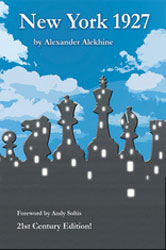
New York 1927; 168 pages; Alexander Alekhine (translation Mary Lawrence); Russell 2010 (original edition 1927)
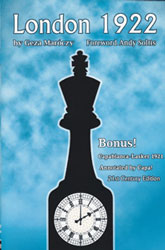
London 1922; Geza Maróczy; 128 pages; Russell 2010

I almost never review beginner's books, how-to-win-at books, or books of tactical exercises, but Graham Burgess' The Mammoth Book of Chess isn't exactly any of these. It serves not only as an introduction to chess and the chess world, but also as an Encyclopaedia of chess information. True, the book starts out with elementary mates and tactics (the rules are put in an Appendix), but by page 90 or so (out of 570), we are involved in some pretty complex endings; and then there follows a 168-page survey of opening material which goes from elementary into master-level territory. Part 1 concludes with the topic of attack and defence. In Part 2, the logistics of chess competition are discussed, for example, finding tournaments, and a long chapter on computers and internet chess. There follows a large section on chess puzzles and endgame studies. Part 3, 'Essential Chess Information', includes a glossary, some history, and the elements of the rules and notation. In short, there's a wealth of chess information, and a something for everyone.
The Mammoth Book of Chess won the 1997 BCF Book of the Year award, and this is the third edition, expanded, revised, and updated. It's a terrific (and inexpensive) work that is particularly suited for those from beginner to club player. And because of its compilation of information and history, the Mammoth Book is a handy work to have around for players of all strengths.

As long as I'm breaking my reviewer's rules, I'll direct your attention to a book of exercises/tactics, Chess Gems: 1000 Combinations You Should Know, written by Igor Sukhin. It's starts on shaky ground, with a Foreword (also called a 'Preface') by Vladimir Kramnik. That sounds impressive, until you read the piece and realize that not only is it dull as dirt, but it's mostly about computers and has little to do with the book at hand!
Okay, having gotten that out of the way, I'll grant you right away that everyone has their favourite book of combinations and/or exercises, just as everyone has their favourite endgame book. In both cases, it's usually one of the first ones they used, or sometimes the one they're using at the moment. (Right now, for example, I'm using Richard Palliser's The Complete Chess Workout: Train your brain with 1200 puzzles! - it's perfect for direct training). But right off you can see that Chess Gems is a unique labour of love. It's organized not by difficulty, theme, or even randomly, but by era. And the first era is the 9th to 15th century! Sure, that's pre-modern, but why not start with problems from Shatranj, even if the rules are different? 10 of the first 11 exercises requires us to use these completely counter-intuitive piece moves; the solutions are quite pretty! Then the book proceeds from 'Lucena to Greco (15th-17th centuries), Stamma to Philidor (18th century), Napoleon to Staunton (1800-1850), and so forth, culminating in "The Great Opposition: Karpov-Kasparov (1981-2000)". This chronological ordering (with Satranj!) is accompanied by brief discussions of the era and the players, with a few stories, and somehow there is still room for 1043 exercises with thorough solutions (i.e., with words, and not just a single move). Another good thing about this collection is that the difficulty of the exercises is unpredictable (rather than getting more difficult with each exercise), something that would improve quite a few books of tactics and/or mates.
A delightful volume. Even the Bibliography makes good reading!

While I'm in the realm of books-that-I-don't normally-review, I usually stay away from books without direct chess content. However, this is a column of exceptions, and I think that Chess Child: The Story of Ray Robson, America's Youngest Grandmaster deserves some words. It is written by Gary Robson, Ray's father, and chronicles both Ray's chess career (without any ganes) and Gary's life. In my opinion, Chess Child is best suited for chess parents, and it might well appeal to parents who are trying to raise a child with strong skills in any area. The title isn't quite accurate (what chess book title is?), because the book is mainly about Gary Robson: his own life story, his personal philosophy and lifestyle, his feelings about work and family, his (changing) feelings about being Ray's father and the role he should play in his life, his experiences while attending chess tournaments as a father/spectator/trainer, and of course his always-difficult decisions about Ray's development as a player (teachers, hours of study, number of tournaments to go to, time needed for other activities in Ray's life, and much more). Gary and his wife Yee-Chen sacrifice a great deal in both time and money (paying for Ray's chess activities and associated travel), and financial worries are a continual theme. Chess Child is, as they say, 'a very frank and revealing look' at the challenges and obstacles that will probably confront any family without exceptional means (or fortunate connections!) in the United States if they want to achieve the maximum for their child's chess development. It's not an easy ride.
Ray himself appears in a rather passive role, and we don't get to know much about him. That is probably inevitable, since he is a young child for most of the book, and there are no chess games! In most of the scenes in which Ray appears, he is busy playing or studying chess, travelling to chess tournaments, preparing, trying with his parents to find time to eat and get good sleep at tournaments, etc. We all know what that entails. In addition, I get the impression from the book that he's somewhat shy. Thankfully, Gary and his wife make sure that there's time for normal kid activities, such as playing a wide variety of sports and games.
I'd like to go into more detail, but will simply say that the literature is thin about how parents deal with the issues surrounding their child's pursuit of a specialised skill. This book is an interesting and potentially controversial contribution to the field. It also addresses the endless debate about the relative roles of talent versus work in becoming a successful player. Gary consistently comes down on the side of hard work and persistence, with a strong dose of character. That philosophy has served Ray well; he has a healthy attitude, and by all indications will have an extremely successful chess career. Finally, for the record, the book makes clear that should Ray choose to pursue a career other than chess, his parents will give him their full support. That's absolutely right, but I selfishly hope that Ray, who is on pace to be an elite player, will choose to pursue our wonderful game for many years to come.

I'm of two minds about the book Champions of the New Millennium, by Lubomir Ftacnik, Danny Kopec and Walter Browne. My initial reaction was unreservedly positive and, to be sure, it remains positive enough that I can recommend it highly for a wide range of readers. Right away one is struck by the brightness and quality of the book. It has an attractive front cover with thumbnails of all 18 featured players (I'll list them below) placed on the squares of a chessboard. Then you begin thumbing through the book and notice the photographs. Now I am a fan ofclassic tournament books with wonderful faded black-and-white portraits of formal, bearded, chessplaying gentlemen. And there are some general historical and encyclopaedic books that have marvellous photos and pictures - Saidy and Lessing's The World of Chess and Fred Wilson's Picture History of Chess come to mind. But I've never seen a single annotated games collection or even biography contain so many striking, clear, and expressive photographs. From the credits, I see that the majority are by Harald Fietz, who has built up a first-class reputation as a photographer of players and events. So right off, chess history buffs and people who simply like pictures of their chess heroes will doubtless want to latch on to a copy. Then we have the freshness of the idea: to present the best players of the time (meaning 2009) with their games and short biographies. There is of course some precedent, such as Reti’s Masters of the Chessboard and later compilations of games (usually over many decades of play); but Champions of the New Millennium is more focused in time, as well as being much more thorough and systematic. The authors have not only produced something outside of the usual chess book genres, but done it with flair, and Quality Chess deserves a lot of credit for getting behind their project.
To be clear, the book is primarily a games collection and not a historic/philosophic work like Reti's Modern Ideas in Chess or Saidy's Battle of Chess Ideas. The discussion of player's styles, for example, is usually very brief and according to stereotype. And sometimes without basis, in my opinion. For example, we find out that "Originally, [Carlsen] was a rather one-dimensional attacking player." Whoever wrote this doubtless thought that he could toss it off without objection - after all, almost all young players are originally single-minded attacking players. But a look at Carlsen's early games contradicts that view, in my opinion, and he's not described in that way by his coach Simen Agdestein. Anyway, I digress. The essence of the book is to acquaint oneself with the players who are fighting for supremacy in contemporary chess. Readers will find out who they are, and the highlights of what they've achieved. They will also have access to some stunningly brilliant games.
Who are these players? Chess fanatics like me (and a good number of you) forget that the clear majority of players out there only know a very limited number of the names of the current top players: Anand, Kramnik, and Carlsen; maybe Topalov, Ivanchuk, or Judith Polgar. But look at the other stars in this book: Aronian, Svidler, Mamedyarov, Shirov, Morozevich, Leko, Kamsky, Karjakin, Wang Yue, Radjabov, Ponomariov, and Grischuk. The authors' original idea was to stay with 'youngish' players (their description); but they started making exceptions. Anand and Ivanchuk had just had good years, so they threw them into the mix, and they also went for some geographical diversity at the cost of pure strength. In the end, any such list is a bit arbitrary, and the combination of rapid decliners and fast-rising superstars will make it look odd in retrospect. But I think it's a good selection, and importantly, these players are original thinkers with plenty to show off.
The games themselves are chosen to be on the brilliant and spectacular side, as most games collections are. I think it would have been nice to have a few more subtle positional struggles, but that's a matter of taste. From a standpoint of reaching the most people, club-level and lower players traditionally enjoy slugfests and direct, forcing games the best. My only problem is with the occasionally poor quality of the commentary and editing. For example, the very first game I looked at was Polgar-Anand, Dos Hermanas 1999. In it, the notes have a strained quality, perhaps in an attempt to 'liven things up'. Take the mixed metaphor in the second sentence: "She then weaves a spectacular stranglehold against one of the strongest players ever". In the next column, we see that White has 'another wind and wooly option'. I understand that 'wind' gets by the spell-checker, but all three authors were supposed to work on each game, and the book lists an editor and three proofreaders! More importantly, the annotator engages in that eternal annotate-by-result fallacy: on move 15, Black plays 15…0-0?, and he says that 'better was 15…Qc7…with a complex game'. The next annotation mark comes with 17.Qe3!, and the next with the move 18…Qb6?!. At that point, the annotator points out that Black had two better defences, and one of them, 18…Re8!, is so good that he concludes that 'Polgar's double piece sacrifice would face a very serious test' (and as far as I can tell, not one it could pass). So why the question mark on 15…0-0, which apparently leads to a winning position? And this continues with the next move where Black makes still another mistake 19...Qh6?!; even after his earlier queried moves, it turns out that he could still have played 19…Rg8! leading to counterplay. Then it's back to the prose: after 22 Bc4 we find that "Vishy is gasping for air as though on a medieval rack with the screws slowly tightening!". And later: "Despite being a piece up Vishy can only move the rook on f8 like a lantern on a sinking ship!". Okay, I understand: this sort of laboured writing isn't a fatal problem if the game is a good one, but it's annoyingly artificial.
To be fair, the next two games I looked at were much better (except for another annotate-by-result issue in one of them), but I still found the commentary off-putting. For example, in another Polgar game, she plays an elegant but also normal attacking move 14 g4, leading to a pretty win. After White's 17th, the annotator says that 'it's almost certain that Judith had this position on the board during her preparation.' She then goes on to win and the writer concludes: "Polgar's fabulous 14 g4!! is one of the strongest 'quiet' moves ever played." Okay, Judith is a tactical wizard, but this is a normal idea, so the rephrasing "one of the 1000 strongest 'quiet' moves ever played" would be closer to the truth. Similarly, in the introduction to an Ivanchuk-Kasparov game, we hear: "Get ready for what may be the Greatest Chess Battle of the final decade of the previous century". Not only is this babyish, but the irony is that the vast majority of other games in this very same book are more exciting and more closely contested!
So you can see that I have certain reservations about Champions of the New Millennium. Nevertheless, they are relatively minor, and the book's positive qualities clearly outweigh its negatives. With it, a fan can become familiar with the stars of the chess world, play through some very exciting games, and enjoy a great set of the photos. If nothing else, this description of the current contenders helps to set the stage for which players will survive the forthcoming battle at the top.

I want to be sure to mention Howard Goldowsky's recent Masters of Technique – The Mongoose Anthology of Chess Fiction. I always enjoy running across chess in art and film, and this book is one of the few pure collections of chess fiction writing that has appeared. Without taking the space to describe individual stories, I'll just note that there is an unusually wide range of plots, with varied points of view and degrees of seriousness. So it's an easy book to browse and settle into whatever strikes your fancy. I would also say that the book is a little more like normal literature than most chess fiction. I have always been fascinated by stories about chess, and they provide a unique view of the game, but the fact is that most of chess fiction is pretty awful. For some reason, even well-known authors struggle haplessly to describe chess players and their world, probably because they don't have a feel for the psychology and concerns of actual players. Moreover, the drama of a game is subtle, and mostly connected to the moves themselves, rather than spectators' reactions or physical behaviour such as expressions of smugness, despair, or anxiety. Among authors who are experienced players, few have proven to have the literary or creative skills to pull off a compelling work. Of the dozen or so 'chess novels' I've read, most of them written during the last 15 years (and most mentioned in the Introduction to Goldowsky's book), I still haven't found anything as good the old classics Schachnovelle by Stefan Zweig (The Royal Game in the English translation) and The Luzhin Defence by Nabakov (also called The Defence). And of shorter works, it's hard to beat Master Jacobsen by Tim Krabbe´, which can be read on his website at http://www.xs4all.nl/~timkr/text/jacobson.htm .
Fortunately, short stories seem to have fared better than novels, although that may be because there are so many there that a few are bound to succeed! We've all read the embarrassingly poor stories that established chess magazines tend to include from time to time. Nevertheless, we find some gems out there, and a good editor/compiler of an anthology can pick them out. I have two story anthologies on my shelves. Sinister Gambits (compiled by Richard Peyton) contains an inconsistent set of murder/mystery stories , several by well-known authors (it also includes The Royal Game). The shorter story collection Pawn to Infinity (compiled by Fred Saberhagen) consists of science fiction stories with chess themes and in my opinion makes a better read. Goldowsky's Masters of Technique is less specialised, and compares favourably with both of these. Granted, as with the other collections, several stories have the usual embarrassing gaffes regarding the technical aspects or jargon of the game. Indeed, it's always surprising with what confidence authors and filmmakers make mistakes about the names of moves, the rules, chess history, and even the legality of positions, when it would be so easy to ask a local player or friend to look over the work before sending it out or filming. But in Masters of Technique these errors are relatively infrequent. More importantly, these stories expand outside of the usual confines of the psychological portraits of players (complete with the predictable suicide) and the portrayals of high-pressure championship matches that so attract the outside observer. I think you'll have fun with this book - it's a gentle escape from routine. Of course, playing chess itself is supposed to be that; unfortunately, it can bring us closer to reality somehow, and more often than we'd like.

Russell Enterprises continues to put out tournament books (see column #95 for three others). Vienna 1922 is practically a brand new book, at least for the public, since it was self-published by Larry Evans in 1948 with only 300 copies. Evans speaks of carbon copy form, and Hanon Russell of mimeographing (which seems more likely). For those of you not old enough to remember (95% of the world's population?), these methods are crude reproductions of typed pages. This new edition includes a crosstable, player index, a Foreword by John Donaldson, and a new Introduction by the author (who died in 2010, just before it went to press). Vienna 1922 was a remarkable tournament where, as Donaldson says, "all the stars of the day (Alekhine, Bogoljubow, Gruenfeld, Maroczy, Reti, Spielmann, Tarrasch and Tartakover) played except Capablanca and Lasker." The tournament featured a remarkable comeback by Akiba Rubinstein (whose his post-World War I results were generally so disappointing); Rubinstein scored 11.5 out of 14 and finished a point and half ahead of Tartakower, and two and a half points ahead of Alekhine. Fans of the great players of old will want to pick up a copy.

Another Russell production is New York 1927 by Alexander Alekhine, translated by Mary Lawrence. It has a fascinating 6-page Foreword by Andy Soltis, who discusses, for example: why New York 1927 never achieved the status that New York 1924; why Lasker and Bogoljubow didn't play (they were the 'highest-rated' in the world by historical ratings, ahead of Alekhine and Capablanca); and Alekhine's harsh criticisms of others' play, especially of Capablanca's opponents. The tournament itself was a romp for Capablanca, who was at his peak, finishing a full three points ahead of Alekhine and four ahead of Nimzowitsch! Al Lawrence, who edited the book, writes a short and interesting essay. He also discusses Alekhine's criticisms of Capablanca, but Lawrence notes that New York 1927 was written after Alekhine had defeated Capablanca for the World Championship.
Remarkably, this is the first edition of New York 1927 in English. It is a real contribution to the literature of the game.

Finally, there's London 1922 by Geza Maróczy, who limits himself to annotations of that tournament (I notice that elsewhere, Watts, who contributed to Nottingham 1936 as well, is given some credit. Perhaps he was the editor). The book has a bonus section of Capablanca's notes to the 14 Capablanca-Lasker World Championship (won by Capablanca).
The most prominent of the 16 entrants were Capablanca, Alekhine, Vidmar, Bogoljubow, Rubinstein, Tartakower Réti, and Yates. Capablanca controlled the tournament, finishing at 13 points out of 15, 1.5 points ahead of Alekhine. Vidmar and Rubinstein followed with 11 and 10.5 points, respectively. Max Euwe was just starting out in international chess and scored 5.5 out of 15, not an awful result considering the competition.
Andy Soltis writes the Introduction and provides two pages of details about the 'London Rules' for the World Championship, which were put together at that time by Capablanca.
To be fair, I should mention that there is another edition of London 1922 with Maroczy's notes and Watts' input. I haven't seen it, but it is put out by Hardinge Simpole, and according to the website "faithfully records Capablanca's victory while reproducing all of his notes from The Times, together with comments from the original tournament book but with all the supporting diagrams that Watts and Maróczy would have wished to include. Their notes are reinforced by a wealth of other authoritative sources such as Alekhine, Sir George Thomas and the regular Times chess correspondent, Tinsley…" This consumes an enormous 388 pages(!) and costs about twice as much as the Russell edition (or perhaps three times as much after an online discount for the Russell). I suppose that the true collector will want both.


 TWIC is 29. First issue 17th September 1994.
TWIC is 29. First issue 17th September 1994.





